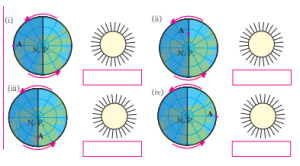Questions Answers For All Chapters – Geography Class 8
Local Time and Standard Time
Q 1. Complete the sentence by selecting the correct option:
(a) The earth requires 24 hours for one rotation. In one hour,
(i) 5 longitudes will face the sun
(ii) 10 longitudes will face the sun
(iii) 15 longitudes will face the sun
(iv) 20 longitudes will face the sun
Answer: (iii) 15 longitudes will face the sun
(b) To calculate the difference between the local times of any two places on the earth,
(i) the noon time at both the places should be known
(ii) the difference in degrees of their longitudes should be known
(iii) the difference in standard times of both the places should be known
(iv) Changes need to be made according to International Date Line
Answer: (ii) the difference in degrees of their longitudes should be known
(c) The difference between the local time of any two consecutive longitudes is
(i) 15 minutes
(ii) 04 minutes
(iii) 30 minutes
(iv) 60 minutes
Answer: (ii) 04 minutes
Q 2. Give geographical reasons:
(a) The local time is decided by the noon time.
Answer:
- The local time of a place is determined by the position of the sun in the sky.
- When the sun is directly overhead, it is considered noon at that place.
- The noon time is the same for all places on the same longitude.
(b) The local time at Greenwich is considered to be the international standard time.
Answer:
- Greenwich is located at 0° longitude, called the Prime Meridian.
- It is used as the reference point for time calculations worldwide, known as Greenwich Mean Time (GMT).
- The world is divided into time zones based on GMT to maintain uniformity.
(c) The standard time of India has been decided by the local time at 82.5° E longitude.
Answer:
- India extends from 68°E to 97°E longitude, covering multiple time zones.
- To avoid confusion, a single standard time is used, based on 82.5°E longitude (near Mirzapur, Uttar Pradesh).
- This ensures synchronization of daily activities across the country.
(d) Canada has 6 different standard times.
Answer:
- Canada has a large longitudinal extent from east to west.
- Due to this, different regions experience sunrise and sunset at different times.
- To maintain proper scheduling, Canada follows six different standard time zones.
Q3: Answer in brief
(a) If it is 12 noon at 60°E longitude, then explain what would be the time at 30°W longitude?
Answer:
- Difference in longitude = 60°E – (-30°W) = 90°
- Time difference = 90° × 4 minutes = 360 minutes = 6 hours
- Since 30°W is west of 60°E, the time there would be 6 hours behind
- Time at 30°W = 12 noon – 6 hours = 6:00 AM
(b) How is the standard time of a place determined?
Answer:
- The standard time of a place is determined based on a centrally chosen longitude within a country.
- This is done to avoid confusion caused by different local times in different regions.
- The longitude used for standard time is usually a multiple of 15° from the Prime Meridian.
- For example, India follows Indian Standard Time (IST) based on 82.5°E longitude.
(c) A football match being played at São Paulo, Brazil started in India at 6 AM IST. Explain what would be the local time at São Paulo?
Answer:
- IST is UTC +5:30, and São Paulo follows UTC -3:00.
- Time difference = 5 hours 30 minutes + 3 hours = 8 hours 30 minutes.
- Since São Paulo is behind India in time,
- Local time at São Paulo = 6:00 AM IST – 8 hours 30 minutes = 9:30 PM (previous day).
Q 4. If it is 10 pm on 21st June at Prime Meridian, write the dates and time at A, B and C in the table.
Answer:
| Place | Longitude | Date | Time |
|---|---|---|---|
| A | 120°E | 22nd June | 6:00 AM |
| B | 160°W | 21st June | 12:40 PM |
| C | 60°E | 22nd June | 2:00 AM |
Q 5. Write the situations of place A shown in these diagrams in the boxes below them :
(i) Sunrise (ii) midnight (iii) noon (iv) Sunset
Answer:
- Sunrise (i): Place A is just coming into the sunlight as the Earth rotates.
- Midnight (ii): Place A is on the opposite side of the sun, experiencing complete darkness.
- Noon (iii): Place A is directly facing the sun, meaning it is midday.
- Sunset (iv): Place A is moving out of the sunlight, indicating evening time.


Leave a Reply